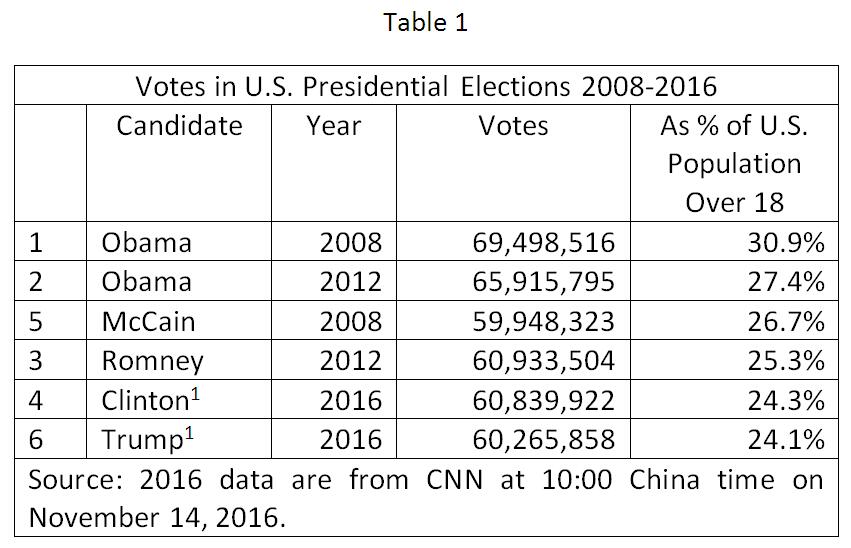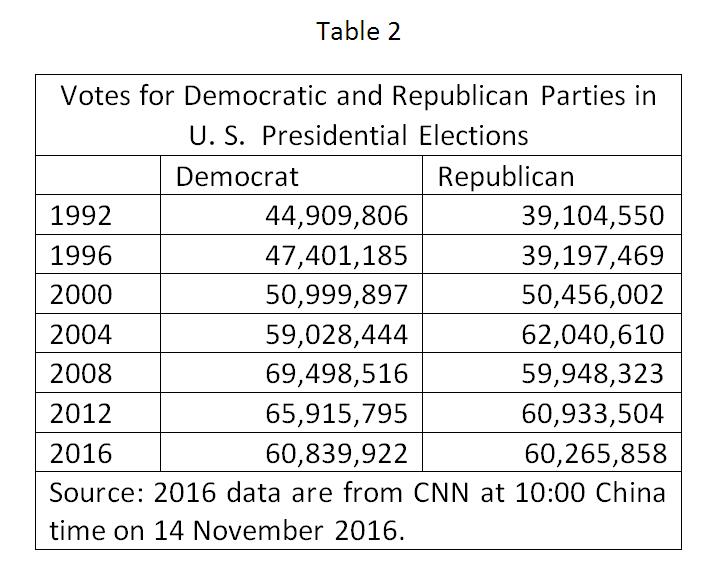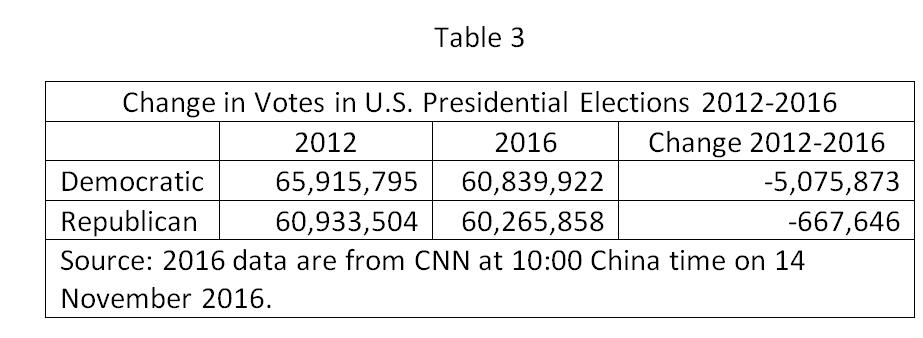What the Presidential election really shows about US politics
- By John Ross
 0 Comment(s)
0 Comment(s) Print
Print E-mail China.org.cn, November 21, 2016
E-mail China.org.cn, November 21, 2016
The election of Trump as U.S. President is an event of world importance. It is therefore particularly important to apply to it the method in the Chinese saying "seek truth from facts." This is made doubly necessary because some articles in the media make claims which are simply in contradiction with the facts. Ignoring facts will necessarily lead to a misunderstanding of the dynamics of Trump both at present and in the future. Therefore, first the facts of the U.S. Presidential election will be given and then the significance of these facts will be analysed.
Trump is not "popular"
Some writers have attempted to claim Trump represents a very popular wave. The facts completely disprove this.
Far from being very popular, Trump received the support of the lowest percentage of the U.S. population of any of the six candidates of either party in the last three U.S. Presidential elections. As Table 1 shows Trump has received the support of only 24.1 percent of the U.S. population over the voting age of 18. This was significantly behind the previous Republican candidates – with Romney gaining 25.3 percent and McCain 26.7 percent. Trump only secured a small increase in votes even in absolute terms compared to McCain in 2008, and since 2008 of course the U.S. population has grown considerably.

Second, most obviously, Hillary Clinton received at the time of writing well over six hundred thousand more votes than Trump. But that figure is likely to increase as the final votes to be announced include postal votes in heavily pro-Clinton California. Nate Cohn, an election analyst at the New York Times, estimates that by the time all votes are counted Clinton may lead Trump by as much as two million votes. So by the test of the number of votes it was not Trump who was popular but Clinton. It was only because non-democratic features of the U.S. electoral system allow a candidate with fewer votes than another to win the election that Trump is President. If the test were popularity in votes cast Clinton would be president not Trump.
Therefore, the facts clearly demonstrate that the claims made in parts of the media that Trump is popular are the reverse of truth.
Trump’s election was due to anti-democratic features of the U.S. political system
Another factually false claim made in sections of the media is that Trump’s election was a "triumph of American democracy." This is clearly entirely contrary to the facts. The 2016 presidential election unusually revealed clearly non-democratic features of the U.S. system.
This is obvious from the result. Clinton won over six hundred thousand more votes than Trump, but Trump was elected president. That a candidate who receives less votes than another is elected is clearly not a triumph of democracy, it is a triumph of "anti-democracy." Trump became president only because the popular vote of the U.S. people was overruled by the U.S. political system.
In the recent period these openly anti-democratic features of the U.S. political system have worsened. In the last 28 years – that is after the Presidential election of 1988 -- the Democrats have won the popular vote in every Presidential election except for 2004 – as shown in Table 2. The Republicans won two out of the last five U.S. Presidential elections only because one of the non-democratic features of the U.S. electoral system is that it gives greater voting weight to small rural, and right wing, areas than to large urban areas.
If the elections had been decided by the popular vote; four out of the five last presidential elections, including 2016, would have been won by the Democrats instead of only two out of five. If Presidential elections had been decided by the popular vote the Democrats would have won six out of the last seven U.S. presidential elections – instead of four out of seven.
This shows a great deal about the non-democratic character of the U.S. political system. But it also shows that the claim of Trump becoming President was a "triumph of democracy" is the exact opposite of the truth. Trump becoming President was a triumph against democracy.

Far from being "popular" Trump is therefore an unpopular candidate of an unpopular party in Presidential elections. It is only the non-democratic character of the U.S. political system that allowed Trump to become President.
Democrats lost the election, the Republicans did not win it
The facts clearly show that the U.S. Presidential election did not represent the "popularity of Trump" – because that popularity did not exist. Nor did it show a "triumph of US democracy" as the candidate who received the most votes did not win and Trump came to office only due to a non-democratic electoral system. The only issue is why the more popular Democrats did not succeed in overcoming the non-democratic character of the U.S. electoral system?
The reason for this is again clear from the facts. This election did not see an increase in votes for Trump, on the contrary his votes fell by over 600,000 compared to Mitt Romney. But Clinton’s vote fell by 5 million compared to Obama’s in 2012 – see Table 3. The issue which has to be explained at the U.S. election is therefore not the popularity of Trump, because it does not exist, but why Democrats failed to vote for Clinton?
The reasons for the collapse in the Democratic vote are easy to find and confirmed by the data – it was massive economic discontent.

The reasons include the long stagnation of the U.S. economy, with annual per capita GDP growth of 0.4 percent since the last quarter of 2007. U.S. median incomes are below their level of 1999 and the top 20 percent of the U.S. population now receive a greater share of incomes than the bottom 80 percent.
Clinton promised nothing credible to ordinary Americans on the economy – as Bernie Sanders pointed out she represented the type of Democrat more interested to be at cocktail parties with the rich than ordinary people. The polls show clearly that the group who did vote overwhelmingly for Trump, and failed to vote for the Democrats, were those who felt they had suffered in the economic crisis. Polls show only 19 percent of Americans who think their financial situation is worse today than in 2012 voted for Clinton and 78 percent voted for Trump, while 63 percent of those who think life for the next generation will be worse voted for Trump also. In short it was massive economic discontent that led to the failure of Democrats to vote for Clinton.
Conclusion
The question of the dynamics of the U.S. is one of the most important questions in the world. The facts of the election clearly establish:
• Trump did not represent a "popular wave" – he had less popular support than any other presidential candidate in recent U.S. political history.
• Trump did not represent a "triumph for democracy" – he represented the triumph of a non-democratic political system against democracy.
• The failure of Democratic electors to vote for Clinton was due to deep economic discontent.
Given the extreme importance for global developments of the trends in the U.S., it is vital that these are studied with the method of "seek truth from facts." To identify the real forces around Trump, and therefore what his policies will be, it is necessary to first accurately analyze the facts of the Presidential election itself.
John Ross is a columnist with China.org.cn. For more information please visit:
http://www.china.org.cn/opinion/johnross.htm
Opinion articles reflect the views of their authors, not necessarily those of China.org.cn.






Go to Forum >>0 Comment(s)